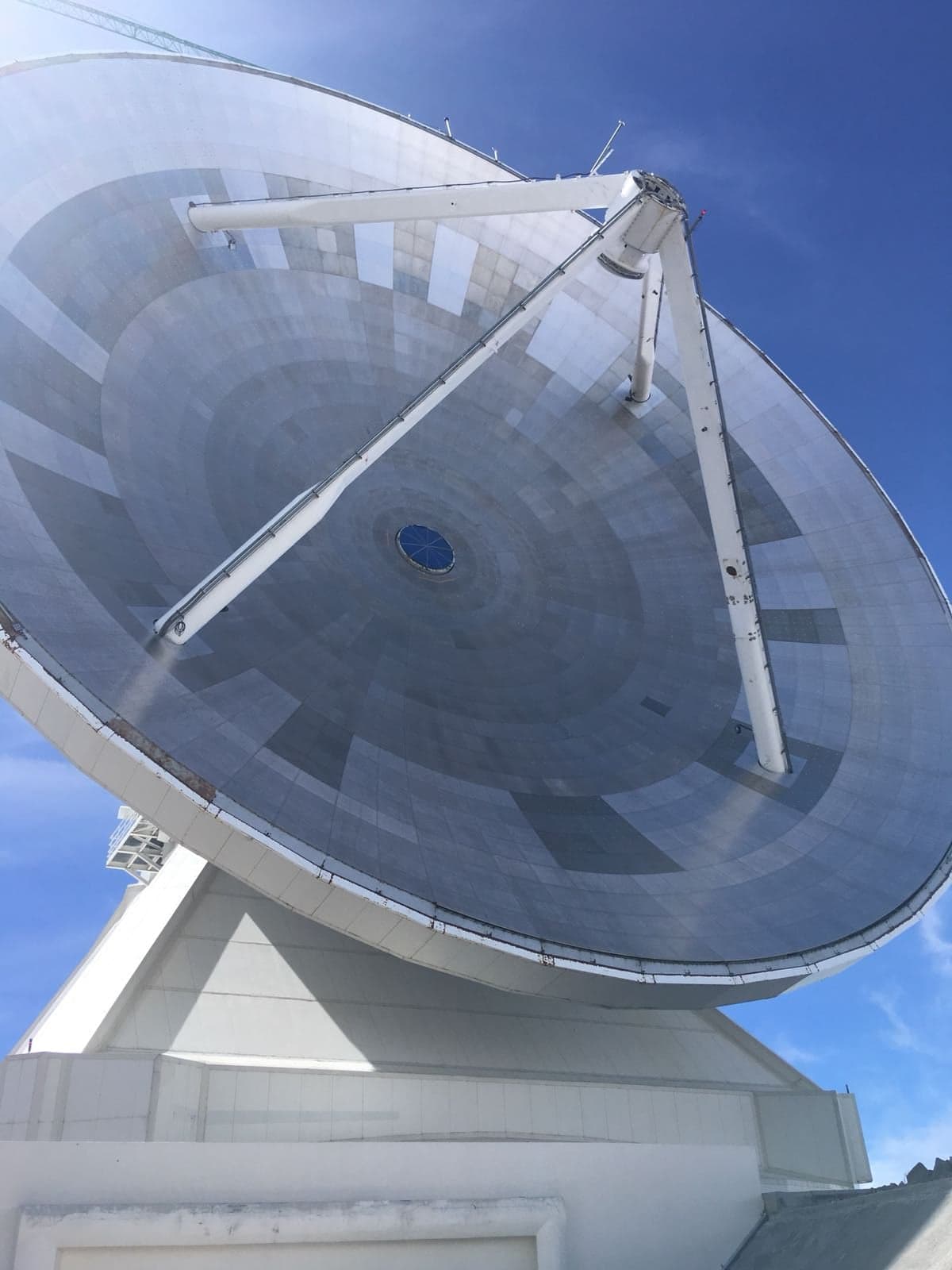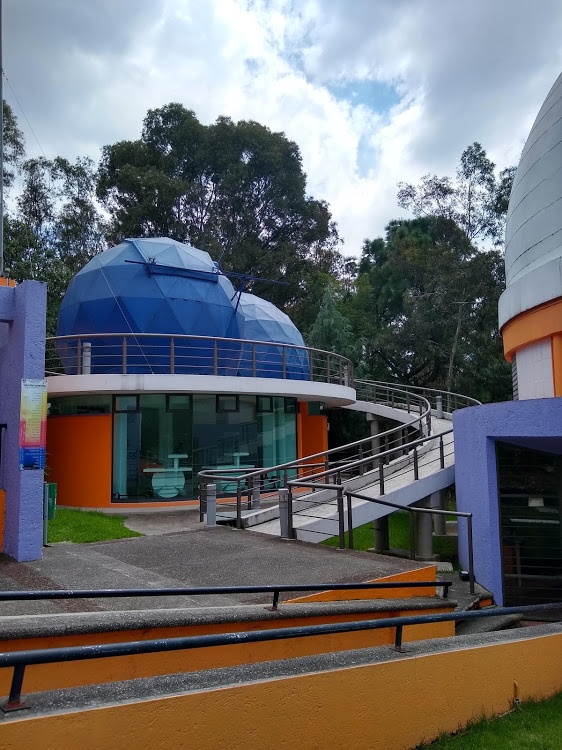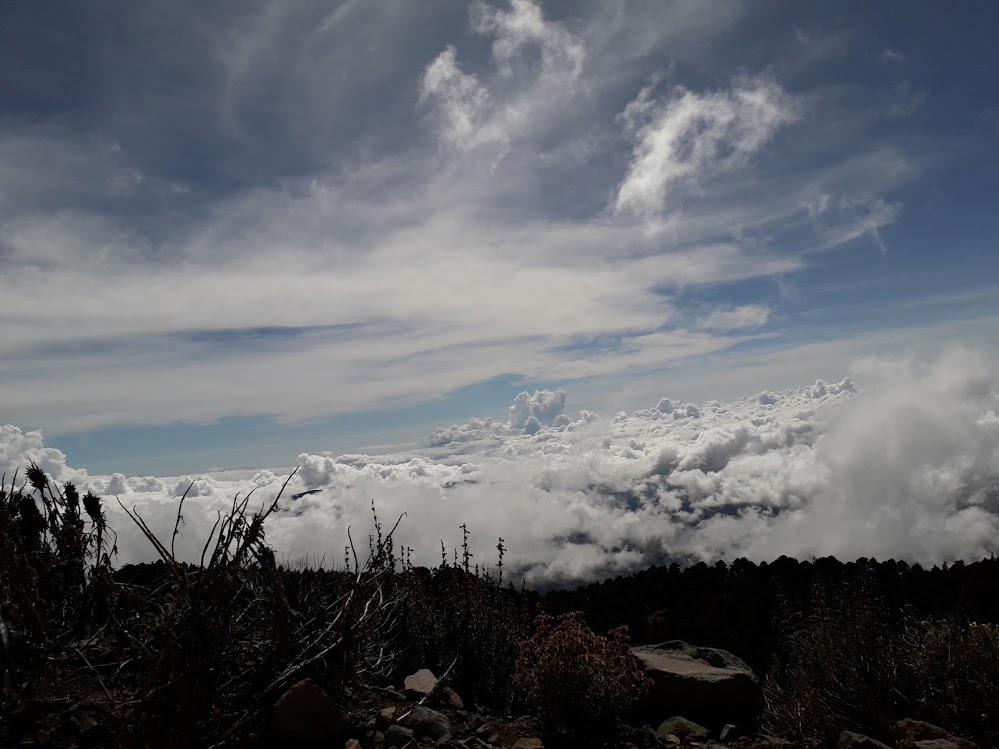Eimear is now a 2018/19 placement year student in the Millimetre Wave Group of RAL Space while she studies Physics with Astrophysics at Nottingham Trent University.
Last month as part of her placement at RAL Space, she had the opportunity to visit the Large Millimetre Telescope (LMT) in Mexico. One of Eimear's major projects while at RAL Space is to develop an instrument for the LMT.
Read her blog below to find out what it was like getting up close to her first major science project, the skills she developed during this trip and how stars will remain in Eimear's eyes for the foreseeable future.
Eimear Gallagher, MMT Group Placement Student, November 2018

I joined STFC RAL Space as a placement student in August 2018 to work on millimetre wave technology (MMT). I am currently working on the ASTEC (Astronomical System Training, Engineering and Collaboration) project. The aim of this project is to install an instrument at the Large Millimetre Telescope (LMT) in Mexico. When starting my placement I wasn’t sure which project I would be assigned to, so when the opportunity came up to work on radio astronomy I was thrilled as it aligns with my interests, I was even more surprised when I was asked if I would like to visit the LMT.
During the interview and application process for my STFC RAL Space placement year I had detailed my experience in astronomy and in particular my interest in radio astronomy. During my studies at Nottingham Trent University, I had used a small 2.3 metre radio telescope but had never thought that I would be spending time at a 50-metre radio telescope- the largest steerable single dish millimetre wave telescope in the world! The opportunities I have had so far whilst working at STFC RAL Space have far surpassed what I thought I would experience, and I’ve only been here four months!
[DAY 1: 13th October 2018]
After lots of researching, packing, submitting paper work, checking plans, preparing task lists and an 11-hour flight, we finally arrived in Mexico City, very tired but very much looking forward to the week ahead and getting to finally see the LMT in person. The LMT is extremely important in the field of radio astronomy, which is the study of the universe using wavelengths of light anywhere from less than a millimetre up to 10 metres or more (the LMT observes in the wavelength range 0.85mm-4mm). Radio telescopes like the LMT are important for observing objects in the universe that are obscured by dust and not perceivable by the human eye or through optical telescopes. However, what we could see with our eyes flying in over Mexico City at night was incredible. The lights stretched out as far as we could see. We got into our hotel, and promptly fell asleep.
[DAY 2: 14th October 2018]
The next morning, we took the three-hour bus journey from Mexico City to Puebla, the fourth biggest city in Mexico. It is very different from busy Mexico City, it felt quieter even though it is home to over two and a half million people - almost twice the number of people who live in my native Northern Ireland. In Puebla, we had the opportunity to visit its incredible cathedral and architecture in Zócalo. The city had a very friendly atmosphere with music playing and street performers.
We were in Puebla to visit the Instituto Nacional de Astrofísica, Óptica y Electrónica (INAOE) who we are working with, alongside the University of Manchester, on upgrading a receiver, which will be placed at the LMT. The receiver will detect the incoming signals from the main dish of the telescope and this signal will then be passed into four spectrometers for analysis. The ASTEC project also aims to enhance the skills of Mexican engineers and scientists in working with complex technology called heterodyne Terahertz receivers. My team will provide transformative training, giving increased expertise and providing scientific data to the Mexican science community. And I get to benefit from this too!
The LMT has a number of instruments all operating at different frequency bands, however the instrument we are installing will be the only room temperature instrument looking at a particular frequency ~345GHz, so will add to the repertoire of what the LMT is capable of observing across different frequency bands and be able to give us new information and data which it previously was not capable of doing.
After the long journey we were getting ever closer to the telescope and reflecting on the implications of the project and the impact it could have meant that I couldn’t wait to see it the next morning. We were all excited to see the place where our instrument will eventually be installed as it gives us a goal to keep in mind when working on the project.
[DAY 3: 15th October 2018]
Finally the day of visiting the Large Millimetre Telescope (LMT), or Gran Telescopio Milimétrico as it is known locally, had arrived. It is called this because it is designed to specifically look at the millimetre wavelengths (0.85mm-4mm) of the radio spectrum.
The day started with being collected in one of the LMT pick-up trucks and driven from Puebla City up to an altitude of 4600m. As we drove the telescope became visible on the side of the mountain, which only increased our excitement. This trip had been planned for weeks and none of us had ever visited such a site before. This was a learning experience for all of us and we were very much looking forward to it after looking at pictures and plans and reading about the work that had been done at the LMT. The LMTs main scientific aim is to “contribute to improvements in our detailed understanding of the formation and evolution of structure, throughout the universe, during its entire history” and it is hoped that the instrument we are installing will be able to contribute to this overall goal.
I had done a lot of research before arriving, and knew already that the telescope had a fifty-metre dish – but knowing this does not prepare you fully for the true scale of the structure. It was vast. It’s incredible to think about the work and planning that was required to build this massive telescope in such a remote location.

As we drove further up the narrow winding road towards the summit of the mountain, known locally as Volcán Sierra Negra, the temperature kept dropping. When we reached the telescope site, we were above the cloud line so that a blanket of clouds covered the towns and cities below. The LMT was built at altitude to try and reduce the amount of signal loss that is caused by the millimetre waves being absorbed as they pass through the atmosphere and to ensure that the telescope gets the maximum signal possible.
The view from the telescope site is something I will never forget, the cold air, the bright sun and the slight feeling of it being harder to breathe when you moved too quickly.
I was absolutely living my dream.
Once inside the telescope, after familiarising ourselves with the building we adventured up to the instrument room, this involved taking two flights of stairs, halfway up these stairs our host suggested taking a break, it was definitely necessary due to the altitude we were at!
A lift took us the rest of the way up to the instrument room. This is where all of the different instruments currently in operation at the LMT are housed - each with its own mirrors, equipment and alignment systems. Each instrument has been carefully planned and positioned, along with its associated mirrors or adaptive optics.
One of our tasks for the trip was to investigate the possible positioning and alignment of our instrument, ensuring it wouldn’t get in the way of any of the others. This meant that there was a lot of time spent with tape measures and a telemeter, measuring distances between mirrors and heights of the other instrument tables currently in use at the telescope. This is made more difficult as the millimetre wave radiation we are trying to align cannot be seen by the naked eye. As such, many instruments will use alignment lasers to simulate where the beam is positioned.
We also had to check what was available at the telescope to ensure that when we return to install the instrument we have all the equipment we need. This was all punctuated, of course, with the occasional stop to go outside and stare in awe at the fact that we were at such a high altitude.
[DAYS 4 & 5: 16th – 17th October 2018]
The following days involved tours of the INAOE campus, meeting other staff and getting to see the incredible clean rooms and labs. We had a teleconference with the Principal Investigator of some of the other LMT instruments to try to better understand them and their operation at the LMT. So much has to be considered from the larger scale optics to the function of components at altitude.
I have learnt that teleconference meetings are common because of the international nature of this project, so setting up a meeting for UK staff who are in Mexico to talk to staff in Massachusetts is nothing out of the ordinary, and I am getting the wonderful opportunity to collaborate with other scientists and engineers all over the world.
The campus itself has a beautiful assortment of observatories, teaching facilities and labs - all inbetween cactus plants, some of which are two stories tall! We also visited Cholula, the town that INAOE is based in. It is a beautiful town with colourful buildings and the largest pyramid in the world.
Returning on the plane the next day my thoughts were full of what I had seen, heard and experienced. I felt energised to get back to RAL Space to work on the receiver and to build on what I had learned. I am very lucky to have been given this opportunity as part of my placement year here at RAL Space and I have learned so many new skills through being involved in this project. RAL Space has incredible opportunities and I would highly encourage other students to apply for the placement year programme as it really gives you the experience of working in science and sets you up for your career.
Since returning to the lab I have found myself looking at the project a little differently. Somehow having seen the telescope with my own eyes has given a new, more tangible context to my daily work in the lab. I really look forward to returning for further work at the LMT.
Images
Image 1 (top right): Me on top of Volcan Sierra Negra summit, an altitude of 4600m!
Image 2 (left): The Large Millimetre Telescope living up to its namesake.
Image 3 (right): When we went to visit INAOE, who are based in Cholula, Puebla.
Image 4 (left): Our view from the telescope site.
Image 5 (right): The incredible cactus plants at the INAOE campus.
Image 6 (middle bottom): Me in front of the Large Millimetre Telescope.
